Pigs are surprisingly easy to potty train, but when they start peeing constantly- it can be a problem.
It surprised me when mine started peeing in the house again. When we started a piggery on our farm, I didn’t think I would fall in love with our pigs so quickly. Before I knew it, a mini pig lived in the house with us. She is a darling and also very intelligent. We have even taught her various tricks.
Things were going well, and she fitted into home-life like a pro. That is, until she constantly peed in places she hadn’t peed before. Our little piggie was already potty trained, so this new behavior was very alarming.
To put my mind at ease, I took my pig to the vet to find out what the issue could be. Our vet examined her and took urine samples to rule out any underlying problems. I was also concerned that she might have picked up a virus from our outdoor pigs.
Why is my pig peeing constantly? Pigs constantly pee for numerous reasons, including obsessive water-drinking behavior (psychogenic water consumption), urinary tract infections, and porcine cystitis-pyelonephritis. Hormone imbalances or fluctuations such as Diabetes Insipidus, territorial marking, and a pig’s heat cycle can also cause continuous peeing.
A pig may also frequently pee because they can’t hold their pee anymore.
7 Reasons For Your Pig Peeing Constantly and the Steps To Take
Let’s take a closer look at seven reasons for your pig peeing constantly and more frequently, as well as the steps you should take to treat them:
1. Psychogenic Water Consumption
Why does my pig pee while drinking? Psychogenic Water Consumption is a condition that causes pigs to drink more water than they need. Pigs urinate while they drink water, but if your pig is gulping down water excessively (gallons at a time), this is cause for concern. Psychogenic Water Consumption was one of the main concerns that I brought up with our vet.
This condition is known as Psychogenic Water Consumption. Your pig will develop the bad habit of drinking more water than their bodies require. More water intake means more urine output. As fast as your pig drinks, the urine will flow out just as quickly.
One of the leading causes of this condition is boredom. If your pig has nothing to entertain them, they start drinking water (similar to how some humans eat when bored). A few symptoms that your pig may display are:
- Regurgitation of water or vomiting
- Choking (from drinking water to fast)
- Swollen belly from the excessive amount of water
- Excessive urination
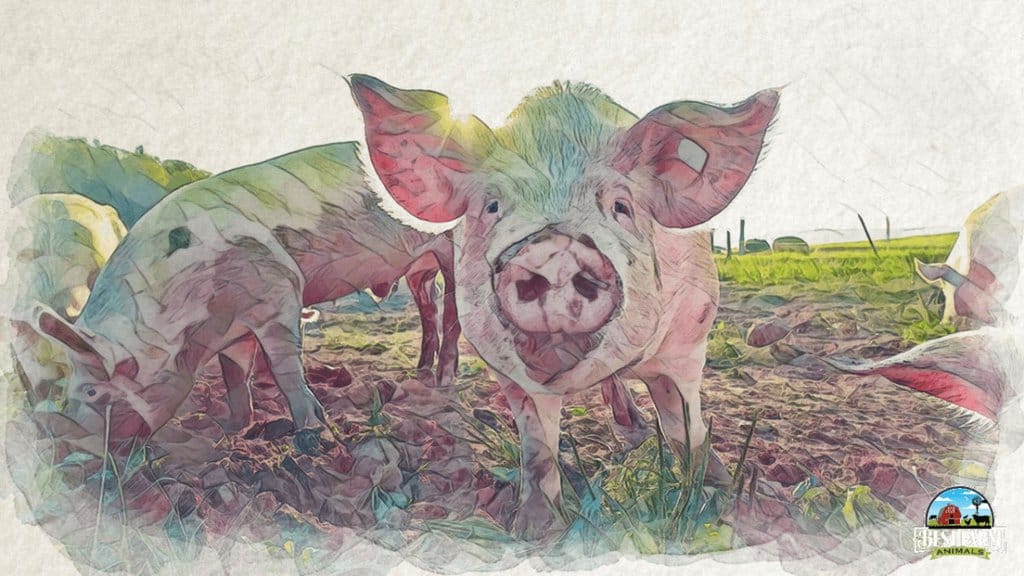
Steps to take if your pig suffers from psychogenic water consumption:
Follow these steps if you suspect your pig suffers from psychogenic water consumption:
- Consult a vet regarding how much water your pig should be drinking daily. Water consumption depends on their weight, size, and the time of year (is it hot or cold?).
- Your vet will place your pig on a 12-hour water fast and run some tests to check for underlying medical conditions.
- Ration the amount of water your pig drinks to prevent them from overdrinking. Water rationing will drastically lessen the volume of urine pigs make.
- Keep your pig outdoors until you have found a solution. This will prevent continuous accidents in your house.
- Set up a sandbox and hide treats like popcorn in the sand to keep your pig mentally stimulated and entertained.
2. Urinary Tract Infections (UTIs)
Urinary tract infections are another reason why your pig may constantly be peeing. UTIs are the most common bacterial infections that affect pigs. Sows (female pigs) are more susceptible to UTIs than males, and they frequently contract this painful condition.
Pigs can contract UTIs when fecal flora (bacteria from feces) enters the urinary tract. Sows often sit in a dog position, putting their vulva in direct contact with fecal matter on the floor. The bacteria travel into the urinary tract and cause infection.
One of the most apparent signs of a UTI is frequent urination. If you’re wondering why your pig’s urine is white, they may have a UTI. The presence of pus in the urine causes the white coloration.
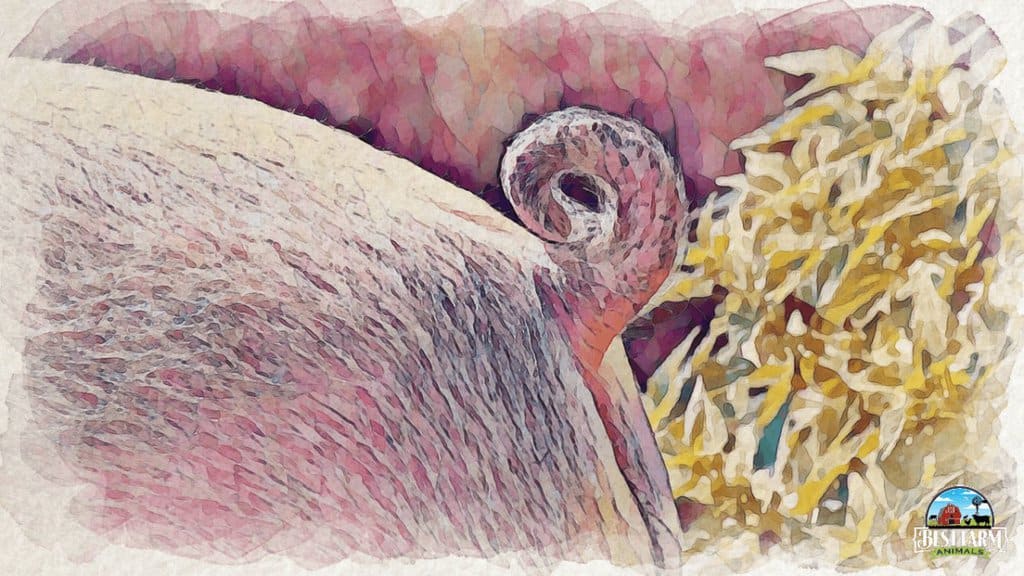
Here’s a look at some other symptoms your pig may experience if they have a UTI:
- Sitting in a dog position with head hanging down
- Blood and pus present in the urine
- Mucous discharge from the vulva (often seen smeared on their tail)
- Weight loss and loss of appetite
- Increased desire to urinate
Good to know: Your pig’s urine should be a clear yellow color. The shades will vary slightly depending on their diet and the amount of water they are drinking.
Steps to take if your pig suffers from UTIs:
Follow these steps if your pig suffers from a UTI:
- Take your pig to the vet for treatment
- Kill the bacteria with broad-spectrum antimicrobials administered as injectables
- The vet may administer a course of Penicillin
- Keep your pig’s living environment clean and hygienic to avoid infection
3. Porcine Cystitis-Pyelonephritis Complex
Porcine cystitis (bladder inflammation)-pyelonephritis (pus) is another common infection in pigs that causes excessive peeing. It is a leading cause of death among sows. Most of these infections result from a nasty bacteria known as Escherichia coli (E.coli).
When sows are lactating, they tend to hold their urine in for longer (to conserve water), and this can also lead to cystitis.
When pigs lie in their filth, they pick up various bacteria that grow in their urinary tracts. Sows also have a terrible habit of lying down and urinating, which can cause infection. Once the bacteria enter their system, it starts to multiply and causes inflammation along the urinary tract to the kidney.
The kidney pelvis begins to erode, which creates pus (pyelonephritis). This process prevents your pig from absorbing sodium and can result in death.
Why is your pig peeing blood? Bloody pee is due to the bacteria Actinobaculum suis, which causes hemorrhagic cystitis and pyelonephritis. The bacteria multiplies and causes damage to the bladder wall and destroys tissues. The blood that you see in the urine is from damaged tissues.
This bacteria can be passed from one pig to another during mating.
Here are a few symptoms your pig may display if they have Porcine Cystitis-Pyelonephritis Complex:
- Frequent urination with only small volumes of urine passed
- Staying in the urination pose for a couple of minutes once the urine flow has stopped
- Grunting while peeing
- Obvious pain
- Hematuria (blood present in the urine)
- Chalky mineral deposits in the urine
- Passes dark-colored urine that has a foul smell
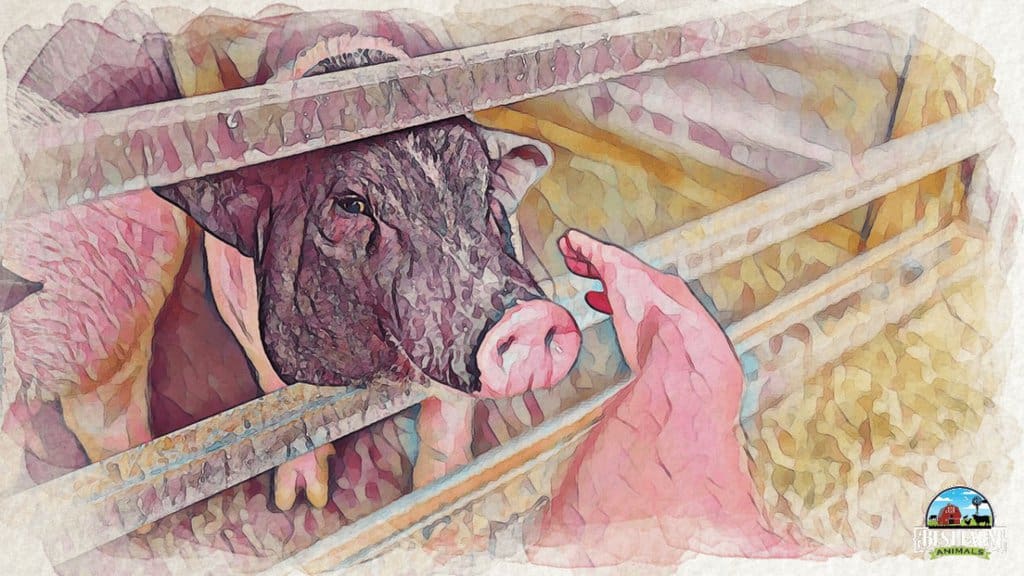
Steps to take if your pig suffers from Porcine Cystitis-Pyelonephritis Complex:
Follow these steps if your pig suffers from Porcine cystitis-pyelonephritis:
- Take your pig to the vet for a urine culture test
- Based on the results, Penicillin injections are advised
- Administer antibiotic treatment in severe cases
- Ensure there is access to fresh water so your pig can flush their urinary system
- Consider keeping your pig outdoors until the infection is gone. Frequent urination will create hard-to-clean stains
- Walk a male pig in front of the sow daily, which will encourage her to urinate while standing
4. Diabetes Insipidus (DI)
Diabetes Insipidus (DI) is a disorder that causes pigs to pee frequently, usually accompanied with orange pee. It happens when the pituitary gland secretes an imbalance of Vasopressin (antidiuretic hormone) in your pig’s brain. As a result, the kidneys retain large volumes of water, making the urine very concentrated (giving it an orange color).
As a result, the kidneys retain large volumes of water, making the urine very concentrated (giving it an orange color). Because the kidneys aren’t functioning correctly, your pig will experience excessive thirst leading to excessive drinking and large or frequent volumes of urine passed.
It’s important to note that diabetes insipidus (DI) is unrelated to blood sugar (Type I and Type 2 diabetes).
Did you know your pig can go from an average urine output of 0.5 gallons a day to 3 or more gallons a day? The volume depends on how severe the disorder is.
An electrolyte imbalance goes hand in hand with DI, which can cause other unpleasant symptoms such as:
- Obvious lethargy
- Hunched over posture due to pain
- Vomiting and diarrhea
- Stunted growth
- Frequent urination
- Loss of appetite
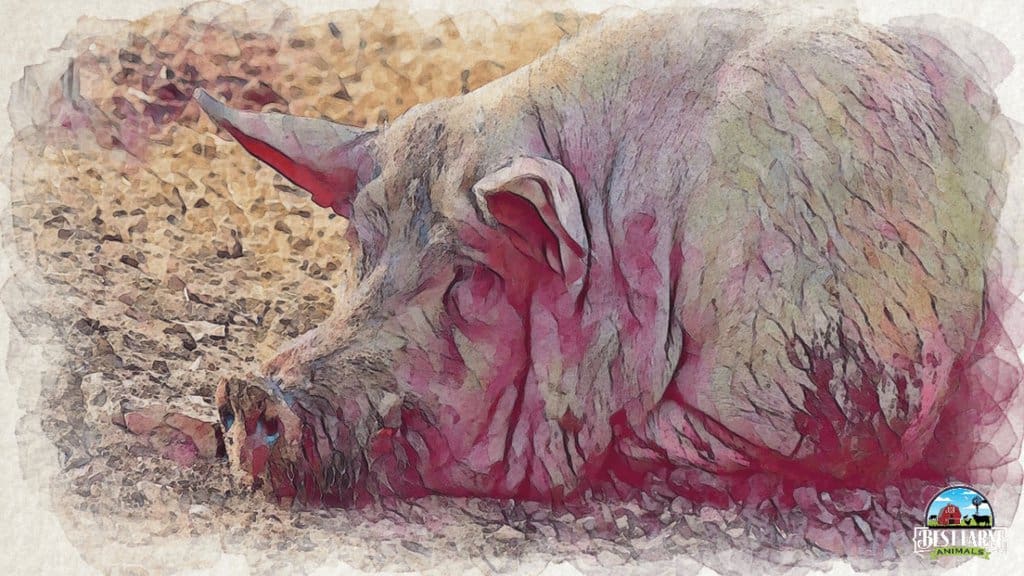
Steps to take if your pig suffers from DI:
Follow these steps if your pig suffers from DI:
- Consult your vet as soon as possible.
- Desmopressin Acetate is the treatment of choice for DI in pigs. An initial dose of two drops is given through the nose and increased gradually to reach an effective dosage.
- Do not restrict your pigs’ water.
- Unfortunately, this treatment will be lifelong for your pig.
5. Marking Their Territory
Pigs pee more often when they feel inclined to mark their territory. Change in the environment, in other companion animals, the introduction of other pigs or people can cause your pig to start marking territory.
Having your pig share your home is great as you can bond with them more. Has something changed recently, and now you’re wondering why your pig is peeing in your house? Sows and boars will mark their territory by urinating or scent marking (small sprays of urine against objects).
If your pig is in heat, this frustrating habit can worsen. Boars also develop a musky smell that sticks to carpets and furniture. A sow will urinate on almost anything to show that she’s in heat. House-peeing can occur even if your pig was previously potty trained.
Steps to take if your pig is marking their territory:
Follow these steps to prevent your pig from marking their territory:
- The best way to stop this territorial behavior is to have your pig sterilized
- Clean any soiled areas thoroughly
- Restrict your pig to a smaller living area while they’re feeling territorial
- Remove any objects they like to mark
- If you notice your pig is about to urinate, say “no” firmly and redirect them to their potty spot
6. Heat Cycle
If your female pig is still intact (not spayed), she will come into heat every 21 days. During this time, the sow’s hormones cause her to urinate frequently to try and attract a mate (this is the sow’s way of flirting). A heat cycle can last anywhere from 36 to 96 hours.
During this time, your sow will show the following signs:
- Restless behavior
- Frequent urination while standing rigid
- Red swollen vulva
- Sniffing and trying to locate a boar
It’s challenging to potty train an unaltered sow, as their hormones will make them pee everywhere instead of in the litter box.
Steps to take if your pig is trying to attract a mate:
- Progesterone can help to control your pig’s heat cycle.
- Spaying your sow will stop her from scent marking (urinating) to try and attract a mate.
- Move your sow outdoors until the heat cycle is over. Your sow will urinate without leaving a mess in your home.
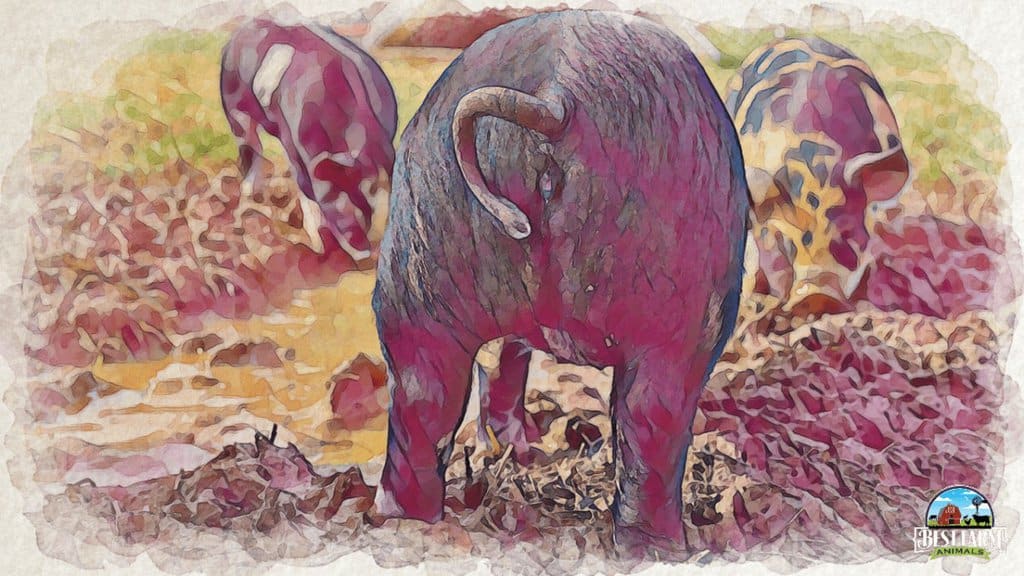
7. Can’t Hold It In
Each pig is different, and some pigs drink more water than others. Often when a pig goes through the potty training process, they don’t make it to the potty in time. This is when accidents occur.
If your pig drinks too much water before bedtime, you might find they urinate in their bed. You might also notice a trail of urine if your pig tries to make their way to the litter box. Some pig owners like to place the litter box close to the water bowl.
Pigs typically urinate while drinking water (this helps to encourage them to use the litter box, as they’ll need to stand in it to drink water). This trick isn’t very effective if a pig likes to drink large volumes of water, as they will fill their bladder again in no time.
Top Tip: A clear sign that your piggie can’t hold it anymore is if they urinate near their sleeping and personal area. Pigs are clean animals and usually don’t like to do this.
Steps to take if your pig can’t hold it in:
If your pig can’t hold their pee in:
- Take your pig to the potty every hour.
- Don’t place the litter tray near their water bowl.
- Place more than one litter tray in their living environment.
- Make sure the litter tray is easily accessible.
- Ration the amount of water your pig drinks.
- Don’t let them drink before bedtime.
How to Get Rid of Pig Pee Smell:
Follow these simple instructions to remove the smell of pig urine in your house effectively:
- Sprinkle baking soda on the urine puddle or old urine stain (baking soda neutralizes urine odors).
- Use gloves to rub the powder gently into the carpet or area where your pig has urinated.
- Leave the baking powder overnight for the most effective odor absorption.
- Wipe or vacuum up the baking powder to remove any odors.
Excessive Pig Peeing Symptoms to Watch For Table
| Symptoms That Accompany Excessive Pig Peeing | Illness or Issue That Cause Frequent Pig Peeing |
| Regurgitating water Choking on Water Swollen Belly Drinking too much water | Psychogenic Water Consumption |
| Sitting with head down, like a dog Pus and blood in the pee Mucus discharge on the rear Weight loss Loss of appetite More frequent urination | Urinary Tract Infection |
| Frequent peeing with little pee Staying in urine pose without peeing Grunting while peeing Shows signs of obvious pain Blood in the Uring Chalky materials in the urine Foul-smelling, dark-colored pee | Porcine-Cystitis |
| Orange urine Lethargy Hunched over position Vomiting and diarrhea Frequent peeing Loss of appetite | Diabetes Insipidus |
| Pig shows signs of being in heat No other symptoms are present Changes in the environment have occurred | Pig is Marking Their Territory |
| Restless behavior Frequent peeing while standing rigid Red, swollen vulva Sniffing to locate a boar | Pig is in Heat |
Natural Cures to Pig Peeing A Lot Problems
Here’s a look at some natural remedies you can use to cure your pig’s peeing problems:
- Cranberries relieve any discomfort your pig may be experiencing from a UTI or Cystitis-Pyelonephritis. Add a couple of cranberries to a orange juice and plain yogurt mixture. This cure has other benefits, such as providing a source of probiotics, vitamins, and minerals.
- Feeding your pig fresh pineapple is known to lower the chance of bacterial or viral infections that cause urinary problems. The medicinal effect is due to the enzyme Bromelain, found in pineapples. The sour fruit also has anti-inflammatory properties, which may help with the impact of porcine-cystitis.
- In some cases feeding your pig-activated charcoal can decrease the growth of harmful bacteria such as E.Coli, which can cause peeing problems if it reaches the urinary tract.

Pig Litter Box Supplies
| Pig Litter Box Supplies | Benefits of Material | Cons of Materials |
| Pine pellets | Cost-effective Good at absorbing pee | Can turn to powder when too much liquid |
| Newspaper pellets | No odor Cost-effective | More costly |
| Wood pellets | Cost-effective | Scatters easily Less absorbent |
| Puppy pee pads | Lightweight No-mess cleanup | Shred easily by pigs More costly Not recyclable |
| Newspapers | Cheap (Free) | No odor control Less absorbent |
| Litter Free Potty Systems | No litter mess Saves money long term | Daily urine dumping potential spills |
Pigs Peeing Constantly FAQs
How much does a pig pee?
Pigs have an average urine output of 0.5 gallons per day. Pigs can range from 2.5 cups of pee daily to peeing just over 2 gallons daily. The more water a pig drinks, the more they’ll urinate. Pigs can also drink water excessively, affecting the quantity of pee daily.
Why is your pig’s urine orange?
Passing orange-colored urine can indicate dehydration in large or dwarf pigs. Medications and diet changes can also affect the color of the urine. Another cause of orange urine is when a pig eats many acorns or carrots.
What if my pig isn’t drinking enough water?
It’s vital to monitor your pig when you ration their water intake. Pigs can suffer from salt poisoning. Salt toxicity happens when they don’t have a high enough water intake to control the salt concentrations.
Salt poisoning can cause:
- Seizures
- Blindness
- Confusion
- Brain damage (in severe cases)
How often do pigs pee and poop?
A healthy dwarf pig should poop (small amounts) 4 to 8 times per day. Dwarf pigs drink a lot of water (up to 2 gallons) daily. When they drink water, they usually urinate at the same time.
Conclusion
I was relieved when my vet informed me that our pig’s urine results were clear. After thorough questioning about our mini-pig’s daily routine (and ours), we finally realized that our pig was a bit bored.
As a result, she was drinking far more water than necessary and peeing constantly. We also have a few water bowls for the dogs and cats in our house. We hadn’t realized that she was drinking from each bowl. As per the vet’s instruction, we rationed her water intake.
As for the peeing in random places, her tiny bladder couldn’t hold the urine for long, and she couldn’t make it to the potty in time. We provided her with a sandbox and some pig-safe toys to keep her entertained.
To learn more about these intelligent animals, read our article on how to care for your pet pig.
My Most Used Pig Supplies
This list contains affiliate products. Affiliate products do not cost more but helps to support BestFarmAnimals and our goal to provide farm animal owners with accurate and helpful information.
Purina Pig Chow will last well (or Mazuri is popular, but I haven’t tried it), and the stainless steel non-skid bowls that will help keep the mess down.
A pig blanket to keep her warm. This one also has bright colors and helps to provide rooting without the destruction.
Pig Harness for walking and handling your pig. There are a lot to choose from, but this one is pretty easy to use. If you want one that has a separate leash, this looks like a good one.
A large crate for keeping her safe in your house at night and when you leave the house. This is essential. You’ll also want a litterbox, and I like mine with a lid for nighttime. Pine shavings are best, and you may be able to find them in larger quantities locally.
When you have accidents, Odoban will help eliminate odors. When you are potty training, these floor pads work great for keeping your house clean while training her to go in certain places.
You’ll also want an outdoor house to keep her warm when she gets outside time, an essential part of her development.
Dewormer- Ivermectin is the primary dewormer I use, although I do rotate with a non-ivermect ingredient once so that the worms don’t get immune to it.

